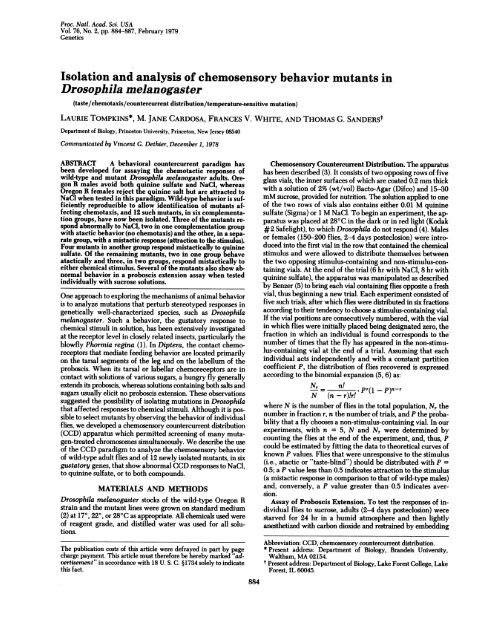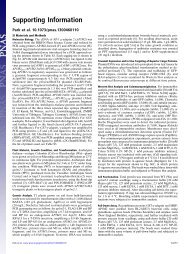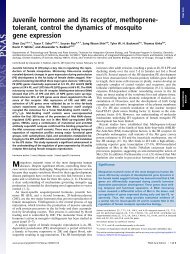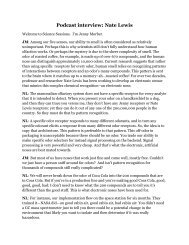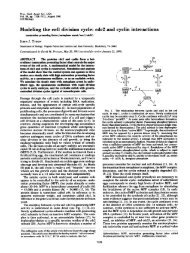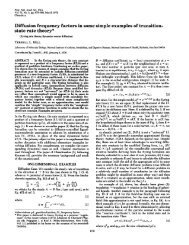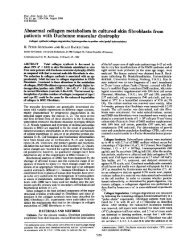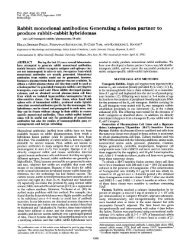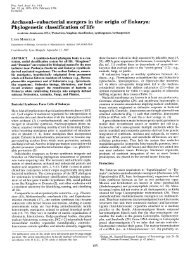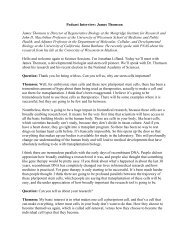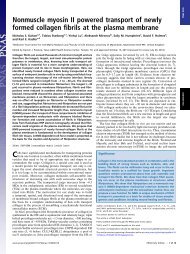Drosophila melanogaster
Drosophila melanogaster
Drosophila melanogaster
Create successful ePaper yourself
Turn your PDF publications into a flip-book with our unique Google optimized e-Paper software.
Proc. Natl. Acad. Sci. USA<br />
Vol. 76, No. 2, pp. 884-887, February 1979<br />
Genetics<br />
Isolation and analysis of chemosensory behavior mutants in<br />
<strong>Drosophila</strong> <strong>melanogaster</strong><br />
(taste/chemotaxis/countercurrent distribution/temperature-sensitive mutation)<br />
LAURIE ToMPKINS*, M. JANE CARDOSA, FRANCES V. WHITE, AND THOMAS G. SANDERSt<br />
Department of Biology, Princeton University, Princeton, New Jersey 08540<br />
Communicated by Vincent G. Dethier, December 1, 1978<br />
ABSTRACT A behavioral countercurrent paradigm has<br />
been developed for assaying the chemotactic responses of<br />
wild-type and mutant <strong>Drosophila</strong> <strong>melanogaster</strong> adults. Oregon<br />
R males avoid both quinine sulfate and NaCl, whereas<br />
Oregon R females reject the quinine salt but are attracted to<br />
NaCl when tested in this paradigm. Wild-type behavior is sufficiently<br />
reproducible to allow identification of mutants affecting<br />
chemotaxis, and 12 such mutants, in six complementation<br />
groups, have now been isolated. Three of the mutants respond<br />
abnormally to NaCI, two in one complementation group<br />
with atactic behavior (no chemotaxis) and the other, in a separate<br />
group, with a mistactic response (attraction to the stimulus).<br />
Four mutants in another group respond mistactically to quinine<br />
sulfate. Of the remaining mutants, two in one group behave<br />
atactically and three, in two groups, respond mistactically to<br />
either chemical stimulus. Several of the mutants also show abnormal<br />
behavior in a proboscis extension assay when tested<br />
individually with sucrose solutions.<br />
One approach to exploring the mechanisms of animal behavior<br />
is to analyze mutations that perturb stereotyped responses in<br />
genetically well-characterized species, such as <strong>Drosophila</strong><br />
<strong>melanogaster</strong>. Such a behavior, the gustatory response to<br />
chemical stimuli in solution, has been extensively investigated<br />
at the receptor level in closely related insects, particularly the<br />
blowfly Phormia regina (1). In Diptera, the contact chemoreceptors<br />
that mediate feeding behavior are located primarily<br />
on the tarsal segments of the leg and on the labellum of the<br />
proboscis. When its tarsal or labellar chemoreceptors are in<br />
contact with solutions of various sugars, a hungry fly generally<br />
extends its proboscis, whereas solutions containing both salts and<br />
sugars usually elicit no proboscis extension. These observations<br />
suggested the possibility of isolating mutations in <strong>Drosophila</strong><br />
that affected responses to chemical stimuli. Although it is possible<br />
to select mutants by observing the behavior of individual<br />
flies, we developed a chemosensory countercurrent distribution<br />
(CCD) apparatus which permitted screening of many mutagen-treated<br />
chromosomes simultaneously. We describe the use<br />
of the CCD paradigm to analyze the chemosensory behavior<br />
of wild-type adult flies and of 12 newly isolated mutants, in six<br />
gustatory genes, that show abnormal CCD responses to NaCl,<br />
to quinine sulfate, or to both compounds.<br />
MATERIALS AND METHODS<br />
<strong>Drosophila</strong> <strong>melanogaster</strong> stocks of the wild-type Oregon R<br />
strain and the mutant lines were grown, on standard medium<br />
(2) at 170, 220, or 280C as appropriate. All chemicals used were<br />
of reagent grade, and distilled water was used for all solutions.<br />
The publication costs of this article were defrayed in part by page<br />
charge payment. This article must therefore be hereby marked "advertisement"<br />
in accordance with 18 U. S. C. §1734 solely to indicate<br />
this fact.<br />
884<br />
Chemosensory Countercurrent Distribution. The apparatus<br />
has been described (3). It consists of two opposing rows of five<br />
glass vials, the inner surfaces of which are coated 0.2 mm thick<br />
with a solution of 2% (wt/vol) Bacto-Agar (Difco) and 15-30<br />
mM sucrose, provided for nutrition. The solution applied to one<br />
of the two rows of vials also contains either 0.01 M quinine<br />
sulfate (Sigma) or 1 M NaCl. To begin an experiment, the apparatus<br />
was placed at 280C in the dark or in red light (Kodak<br />
#2 Safelight), to which <strong>Drosophila</strong> do not respond (4). Males<br />
or females (150-200 flies, 2-4 days posteclosion) were introduced<br />
into the first vial in the row that contained the chemical<br />
stimulus and were allowed to distribute themselves between<br />
the two opposing stimulus-containing and non-stimulus-containing<br />
vials. At the end of the trial (6 hr with NaCl, 8 hr with<br />
quinine sulfate), the apparatus was manipulated as described<br />
by Benzer (5) to bring each vial containing flies opposite a fresh<br />
vial, thus beginning a new trial. Each experiment consisted of<br />
five such trials, after which flies were distributed in six fractions<br />
according to their tendency to choose a stimulus-containing vial.<br />
If the vial positions are consecutively numbered, with the vial<br />
in which flies were initially placed being designated zero, the<br />
fraction in which an individual is found corresponds to the<br />
number of times that the fly has appeared in the non-stimulus-containing<br />
vial at the end of a trial. Assuming that each<br />
individual acts independently and with a constant partition<br />
coefficient P, the distribution of flies recovered is expressed<br />
according to the binomial expansion (5, 6) as:<br />
N (n - r)!r! ( )<br />
where N is the number of flies in the total population, NM the<br />
number in fraction r, n the number of trials, and P the probability<br />
that a fly chooses a non-stimulus-containing vial. In our<br />
experiments, with n = 5, N and N, were determined by<br />
counting the flies at the end of the experiment, and, thus, P<br />
could be estimated by fitting the data to theoretical curves of<br />
known P values. Flies that were unresponsive to the stimulus<br />
(i.e., atactic or "taste-blind") should be distributed with P =<br />
0.5; a P value less than 0.5 indicates attraction to the stimulus<br />
(a mistactic response in comparison to that of wild-type males)<br />
and, conversely, a P value greater than 0.5 indicates aversion.<br />
Assay of Proboscis Extension. To test the responses of individual<br />
flies to sucrose, adults (2-4 days posteclosion) were<br />
starved for 24 hr in a humid atmosphere and then lightly<br />
anesthetized with carbon dioxide and restrained by embedding<br />
Abbreviation: CCD, chemosensory countercurrent distribution.<br />
* Present address: Department of Biology, Brandeis University,<br />
Waltham, MA 02154.<br />
t Present address: Department of Biology, Lake Forest College, Lake<br />
Forest, IL 60045.
Genetics: Tompkins et al.~~~~~Proc.<br />
Nati. Acad. Sci. USA 76 (1979) 885<br />
Genetics: Tompkins et al.<br />
the wings in Takiwax (Cenco, Chicago). After recovery, each<br />
fly was stimulated with distilled water until it no longer extended<br />
its proboscis and then stimulated tarsally with a'0.06 M<br />
sucrose solution while the position of the proboscis was observed.<br />
In no case was the proboscis permitted to contact the sugar solution.<br />
Mutant Isolation. To generate populations that were predominantly<br />
male, virgin females bearing an attached X chromosome<br />
homozygous for the temperature-sensitive lethal<br />
mutation 1(1 )E6's were mass-mated to Oregon R males at 280C<br />
(7). This mutation causes females, which inherit attached X<br />
chromosomes from their Mothers, to die as larvae or pupae (8).<br />
Male progeny of this cross were treated with 25 mM ethyl<br />
methanesulfonate (9) and then mass-mated to virgin attached-X<br />
females. The male progeny of this cross, which inherit mutagen-treated<br />
X chromosomes from their fathers, were tested by<br />
CCD. Each fly remaining in the starting vial at the end of the<br />
experiment, which had thus chosen the stimulus-containing vial<br />
five times in five trials, was mated individually to virgin attached-X<br />
females to generate a putative gus mutant stock.<br />
Males from each stock were subsequently tested twice by CCD,<br />
and stocks that displayed abnormal phenotypes in both experiments<br />
were considered confirmed gus mutants and retained<br />
for additional analysis.<br />
Genetic Analysis. Hemizygous males were maintained in<br />
stock with attached-X females. To generate females to be tested<br />
with quinine sulfate, the following crosses were done. Hemizygous<br />
gus males were mated to virgin females homozygous<br />
for the FM7a X chromosome balancer, Ino() FM7a, y3ld sc8<br />
Wa v B (10), to generate heterozygous gus/FM7a females.<br />
These were then mated as virgins to males bearing the same gus<br />
mutation to generate parents for homozygous gus stocks. For<br />
complementation analysis, virgin females homozygous for one<br />
gus allele were crossed to males hemizygous for another, and<br />
their female offspring were tested by CCD.<br />
Unlike Oregon R males, Oregon R females are attracted to<br />
NaCl when tested by CCD (see below). Thus it was not possible<br />
to observe the effect of gus mutations in normal females by<br />
using NaCl as stimulus, because mutant and wild-type phenotypes<br />
could not readily be distinguished. For analyzing such<br />
mutants, this problem was circumvented by using diplo-X flies<br />
bearing the dsXD mutation on the third chromosome (1 1, 12),<br />
which transforms genetic females into morphological intersexes<br />
(13). We observed that dsxD flies avoid NaCl. Accordingly, we<br />
tested populations of transformed flies that were heterozygous<br />
and homozygous for gus mutations to determine dominance<br />
and complementation of gus mutants with NaCI as stimulus.<br />
The gus genes were roughly mapped with respect to the<br />
visible markers yellow (y; 1-0.0), crossveinless (cv; 1-13.7),<br />
vermilion (v; 1-33.0) and forked (f; 1-56.7) (11). We observed<br />
that these markers had no effect on contact chemoreception.<br />
Ten to 20 F2 males representing each of the six possible single<br />
recombinant classes, as well as an equal number from each of<br />
the two parental classes, were mated to virgin attached-X females,<br />
and males from each of the resulting eight progeny<br />
populations were tested separately by CCD (14).<br />
RESULTS<br />
Before using the countercurrent device for mutant selection,<br />
it was necessary to ascertain that flies were distributed solely<br />
on the basis of their chemotactic behavior. This assumption<br />
predicts that the distribution of flies tested by CCD without a<br />
stimulusrt be%, cha-rn-acterized by, a P valuea equval to.5,-%Ar as is0 true<br />
for the Oregon R wild-type strain from which all mutant lines<br />
were derived (Fig. 1). In the next experiments, the concentra-<br />
0<br />
C<br />
0.3<br />
0.2<br />
L1_ 0.1<br />
C<br />
0.4-<br />
0.3-<br />
0.2-<br />
0.1<br />
0 1 2 3 4 5<br />
Countercurrent tube<br />
FIG. 1. Countercurrent distributions of Oregon R males in the<br />
absence of a stimulus (A) and with NaCi (B) and quinine sulfate (C)<br />
as stimuli. Data from one representative experiment are shown.<br />
tions of NaCl, quinine sulfate, and the background sucrose, as<br />
well as the duration of the trials, were adjusted to maximize<br />
negative chemotaxis by wild-type males. For the optimal<br />
variables, both Oregon R males and females exhibited pronounced<br />
avoidance of quinine sulfate. In contrast, whereas<br />
Oregon R males avoided NaCl (Fig. 1), Oregon R females were<br />
attracted to the stimulus (Fig. 2). Intersexes produced with the<br />
dsxD mutation were repelled by NaCl, although their avoidance<br />
was not as pronounced as that of wild-type males. These data<br />
are presented in Table 1.<br />
After mutagenesis, approximately 17,500 chromosomes were<br />
screened, yielding 69 putative gustatory mutants of which 12<br />
were confirmed. All were sex-linked and fully recessive, the<br />
0.4-<br />
0<br />
0~0.3<br />
20.<br />
U. 0.1<br />
0 1 2 3 4 5<br />
Countercurrent tube<br />
FIG. 2. Countercurrent distributions of Oregon R females (0)<br />
and genetically transformed (dsxD) intersexes (0) with NaCl as<br />
stimulus. Data from one representative experiment are shown.
886 Genetics: Tompkins et al.<br />
Table 1. Responses of Oregon R males and females and of dxsD<br />
intersexes to stimuli<br />
Stimulus<br />
Sex QS* NaCl None Sucrose<br />
Males 0.90 t 0.04 0.84 + 0.05 0.52 + 0.03 0.89<br />
Females 0.86 + 0.05 0.35 + 0.08 0.50 i 0.04 0.85<br />
Intersexes 0.90 + 0.02 0.72 + 0.04 0.52 i 0.02 0.90<br />
Responses to quinine sulfate, NaCl, and no stimulus were assayed<br />
by CCD; P values are +SEM. Responses to sucrose were assayed by<br />
proboscis extension; the fraction of flies responding to 0.06 M sucrose<br />
is shown.<br />
* Quinine sulfate.<br />
phenotype in each case being wild-type in gus/+ females tested<br />
with quinine sulfate or transformed gus/+ intersexes tested<br />
with NaCl. In addition, all populations of gus males responded<br />
abnormally whether the experiment was begun in a stimuluscontaining<br />
or non-stimulus-containing vial, demonstrating that<br />
the genetic lesion in each case affects contact chemoreception<br />
rather than simply reducing mobility.<br />
The gus mutants were distributed among six complementation<br />
groups, designated A through F. All except C, which is<br />
located between the markers crossveinless and vermilion, map<br />
between vermilion and forked, which are 23.7 map units apart.<br />
The mutants may be classified by their patterns of CCD behavior:<br />
those in complementation groups A, C, D, and E exhibited<br />
mistactic responses to one or both stimuli (P values less<br />
than 0.5), whereas those in the B and F groups behaved atactically<br />
(P = 0.5), as shown in Table 2. No mutant exhibited<br />
atactic behavior with one stimulus and a mistactic response to<br />
the other.<br />
In the mistactic class, all four gusA mutants responded abnormally<br />
to quinine sulfate (Fig. 3) and normally to NaCl. In<br />
contrast, gusCNlO behaved normally when tested with quinine<br />
Table 2. Responses of the gustatory mutants to stimuli<br />
Group Mutant(s) QS*<br />
Stimulus<br />
NaCl Sucrose<br />
A gusAQ1 0.22 4 0.04 0.90 4 0.02 0.08<br />
gusAQ2 0.20 i 0.05 0.86 ± 0.03 0.26<br />
gusAQ3 0.25 + 0.03 0.88 ± 0.03 +<br />
gusAQ6 0.26 + 0.06 0.88 ± 0.04 0.44<br />
B gusBQ4 0.50 0.05 0.52 ± 0.04 0.12<br />
gusBQ5 0.49 + 0.06 0.50 ± 0.07 0.21<br />
C gusCNlO 0.90 ± 0.04 0.18 + 0.04 0.94<br />
D gusDN9 0.18 ± 0.03 0.20 ± 0.03 0.90<br />
gusDNl2 0.11 ± 0.03 0.15 + 0.02 0.78<br />
E gusENl3 0.10 ± 0.02 0.13 ± 0.04 0.43<br />
F gusFN5 0.90 ± 0.03 0.50 + 0.03 0.92<br />
gusFN32 0.91 ± 0.05 0.48 0.05 0.92<br />
Responses to quinine sulfate and NaCl were assayed in males by<br />
CCD; P values are +SEM. Responses to sucrose were assayed by<br />
proboscis extension; the fraction of flies responding to 0.06 M sucrose<br />
is shown. Letters A through F designate the different gus complementation<br />
groups. Superscripts Q and N refer to the stimulus, quinine<br />
sulfate or NaCl, with which each mutant was originally isolated. For<br />
conditional mutants, the responses shown are those observed when<br />
flies were raised at nonpermissive temperatures.<br />
* Quinine sulfate.<br />
Proc. Natl. Acad. Sci. USA 76 (1979)<br />
0<br />
.°0.2_ \<br />
LL0.1 CI<br />
0 1 2 3 4 5<br />
Countercurrent tube<br />
FIG. 3. Countercurrent distributions of gusA Ql males, raised at<br />
22°C, with quinine sulfate as stimulus. Data from one representative<br />
experiment are shown. All other mistactic distributions are similar,<br />
the distance of the peak from the center being proportional to the<br />
degree of attraction to the stimulus.<br />
sulfate but exhibited a mistactic response to NaCl. The four<br />
gusA mutants and the single gusC mutant are all cold sensitive:<br />
the mistactic phenotype was expressed in flies grown at 220 C,<br />
whereas populations grown at 28°C responded as Oregon R<br />
males did.<br />
The remaining mistactic mutants exhibited abnormal phenotypes<br />
with both quinine sulfate and NaCl. Of the gusD<br />
mutants, gusDN9 is expressed unconditionally, while gusDNl2<br />
is heat sensitive, males raised at 17°, 220, and 280C being distributed<br />
with P values of 0.90 + 0.02, 0.60 + 0.04, and 0.11 ±<br />
0.03, respectively, when tested with NaCl. The gusE mutant<br />
is cold sensitive, showing mistactic behavior when raised at<br />
220C and normal behavior when raised at 280C.<br />
Of the atactic mutants, the two gusB mutants responded<br />
abnormally to either quinine sulfate or NaCl when tested by<br />
CCD (Fig. 4). The two gusF mutants were atactic when tested<br />
with NaCl but normal with quinine sulfate. All four atactic<br />
mutants were unconditional, the abnormal phenotype in each<br />
case being expressed in flies grown at either 220 or 280C.<br />
In addition to their CCD phenotypes, several of the gus<br />
mutants displayed abnormal behaviors when tested by the<br />
proboscis extension assay with 0.06 M sucrose (Table 2). For all<br />
of the mutants in complementation groups A, B, and E, fewer<br />
than half of the flies tested gave positive responses to the sugar.<br />
In contrast, almost all Oregon R and gusC, gusD, and gusF flies<br />
responded to the sucrose solution. We asked whether the abnormal<br />
response to sugar of gusE N13, the most extreme coldsensitive<br />
mistactic mutant, was similarly temperature sensitive.<br />
Accordingly, males raised at 220and 280C were tested by the<br />
proboscis extension assay. The response of mutant flies grown<br />
at 28°C was indistinguishable from that of Oregon R males<br />
Countercurrent tube<br />
FIG. 4. Countercurrent distributions of gusBQ4 males with quinine<br />
sulfate as stimulus. Data from one representative experiment<br />
are shown. All other atactic distributions are similar.
Genetics: Tompkins et al.<br />
raised at that temperature, which is true of the mistactic CCD<br />
phenotype also.<br />
DISCUSSION<br />
Populations of wild-type (Oregon R) D. <strong>melanogaster</strong> adults<br />
respond with highly reproducible distributions to quinine sulfate<br />
and NaCl when tested by CCD. The two chemical stimuli<br />
used in the CCD paradigm were chosen because they had been<br />
shown to be repellent to flies in other assays (15-17); thus, the<br />
responses of Oregon R males to both compounds and of Oregon<br />
R females to the quinine salt were not unexpected. However,<br />
the positive chemotaxis observed with Oregon R females tested<br />
with NaCl was not expected from previous observations. One<br />
finding that may be relevant to this point is that dsxD intersexes,<br />
whose ovipositors are rudimentary and heavily sclerotized (18),<br />
avoid NaCl. In Phormia there are chemoreceptors on the ovipositor<br />
that respond electrically to NaCl (19, 20); if analogous<br />
receptors mediate the behavior of normal <strong>Drosophila</strong> females<br />
to NaCl, then dsxD flies would be expected to behave more like<br />
males, because their ovipositors do not appear to bear functional<br />
chemoreceptors. This interpretation is also supported by the<br />
observation that female Oregon R larvae avoid NaCI (L.<br />
Tompkins, unpublished results).<br />
Analysis of gus mutant behavior shows that the chemosensory<br />
countercurrent device can be used to select various mutants<br />
with aberrant chemotaxis. Some mutants respond abnormally<br />
to quinine sulfate or to NaCl but not to both compounds. This<br />
result would be expected for mutations that act at the receptor<br />
level, because quinine salts hyperpolarize blowfly chemoreceptors,<br />
antagonizing generator potentials induced by sugars<br />
and salts (21), whereas 1 M NaCI usually stimulates electrical<br />
activity in the blowfly cation receptor (22). On the other hand,<br />
mutations perturbing functions in the central nervous system<br />
could affect responses to NaCI, to quinine sulfate, or to both<br />
compounds. In this regard, the existence of gus mutations which<br />
alter the proboscis extension response is of practical significance,<br />
because mutations that are detectable in individual flies can be<br />
analyzed with genetic mosaics to locate anatomical foci for<br />
mutant behavior (23). It is also possible to record electrical activity<br />
from chemoreceptors in <strong>Drosophila</strong> (17, 24), which will<br />
allow direct observation of the effect of gus mutations on receptor<br />
function. Finally, the heat- and cold-sensitive mutants<br />
are particularly useful, because they can be exploited for<br />
temperature-shift analysis to determine the time in development<br />
during which the gus gene products act (25). By identifying<br />
when and where the gustatory genes function, it should<br />
thus be possible to dissect parts of the nervous system mediating<br />
contact chemoreception in <strong>Drosophila</strong>.<br />
Proc. Natl. Acad. Sci. USA 76 (1979) 887<br />
Note Added in Proof. Rodrigues and Siddiqi (28) have isolated six gus<br />
mutants, in four genes, with abnormal responses to NaCl, quinine<br />
sulfate, sucrose, or all three compounds.<br />
We thank the reviewers for their comments on the manuscript. This<br />
work was supported by U.S. Public Health Service Grant GM 20770<br />
and was presented in part at the annual meetings of the Genetics Society<br />
of America in 1974 and 1977 (refs. 26 and 27).<br />
1. Dethier, V. G. (1969) Adv. Study Behav. 2, 111-266.<br />
2. Lewis, E. B. (1960) <strong>Drosophila</strong> Inform. Serv. 34, 117-118.<br />
3. Tompkins, L., Fleischman, J. A. & Sanders, T. G. (1978) <strong>Drosophila</strong><br />
Inform. Serv. 53, 211.<br />
4. Hamilton, W. F. (1922) Proc. Natl. Acad. Sci. USA 8, 350-<br />
353.<br />
5. Benzer, S. (1967) Proc. Natl. Acad. Sci. USA 58, 1112-1119.<br />
6. Craig, L. C. (1944) J. Biol. Chem. 155,519-534.<br />
7. Grigliatti, T. A., Hall, L., Rosenbluth, R. & Suzuki, D. T. (1973)<br />
Mol. Gen. Genet. 120, 107-114.<br />
8. Grigliatti, T. & Suzuki, D. T. (1970) Proc. Natl. Acad. Sci. USA<br />
67, 1101-1108.<br />
9. Lewis, E. B. & Bacher, F. (1968) <strong>Drosophila</strong> Inform. Serv. 43,<br />
193.<br />
10. Merriam, J. R. (1969) <strong>Drosophila</strong> Inform. Serv. 44, 101.<br />
11. Lindsley, D. L. & Grell, E. H. (1968) Genetic Variations of<br />
<strong>Drosophila</strong> <strong>melanogaster</strong>, Carnegie Institute Publication No.<br />
627 (Carnegie Institute, Washington, D.C.).<br />
12. Denell, R. E. & Jackson, R. (1972) <strong>Drosophila</strong> Inform. Serv. 48,<br />
44-45.<br />
13. Gowen, J. W. (1942) Anat. Rec. 84, 458 (abstr.).<br />
14. Konopka, R. J. & Benzer, S. (1971) Proc. Natl. Acad. Sci. USA<br />
68,2112-2116.<br />
15. Dethier, V. G. (1951) J. Gen. Physiol. 35,55-65.<br />
16. Quinn, W. G., Harris, W. & Benzer, S. (1974) Proc. Natl. Acad.<br />
Sci. USA 71, 708-712.<br />
17. Falk, R. & Atidia, J. (1975) Nature (London) 254,325-326.<br />
18. Fung, S.-T. C. & Gowen, J. W. (1957) J. Exp. Zool. 134,515-<br />
532.<br />
19. Wolbarsht, M. L. & Dethier, V. G. (1958) J. Gen. Physiol. 42,<br />
393-412.<br />
20. Wallis, D. I. (1962) J. Insect Physiol. 162, 453-467.<br />
21. Morita, H. & Yamashita, S. (1959) Science 130, 922.<br />
22. Evans, D. R. & Mellon, D. (1962) J. Gen. Physiol. 45, 651-<br />
661.<br />
23. Hotta, Y. & Benzer, S. (1970) Proc. Natl. Acad. Sci. USA 67,<br />
1156-1163.<br />
24. Isono, K. & Kikuchi, T. (1974) Jpn. J. Genet. 49, 113-124.<br />
25. Suzuki, D. T. (1970) Science 170, 695-706.<br />
26. Cardosa, M. J., Fleischman, J. A., & Sanders, T. G. (1974) Genetics<br />
77, s9 (abstr.).<br />
27. Tompkins, L. & Sanders, T. G. (1977) Genetics 86, s64<br />
(abstr.).<br />
28. Rodrigues, V. & Siddiqi, 0. (1978) Proc. Indian Natl. Acad. Sci.<br />
Sect. B 87, 147-160.


